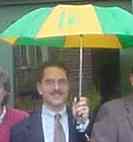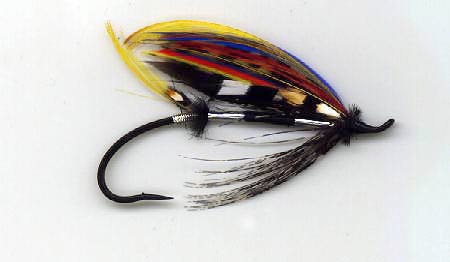

Other great web resources include:
- the
Virtual
Flyshop. Check out the Fly-tier's
Bench and the Pacific
Northwest Regional Center.
- westfly.com
and
its superstar cast of contributors, including editor Scott
Richmond, angling writer Dave
Hughes, and entomologist
Rick Hafele.
Learn all about fishhooks at "The Hook Book." Includes a useful cross-reference chart for fly hooks.
The writings of Roderick Haig-Brown are mandatory reading for anglers and conservationists. Here is one of his fly patterns, the Silver Brown. To learn more about Haig-Brown and his legacy, visit the websites of the Haig-Brown House Education Centre and Pacific Coast Salmon Fisheries education project.
Bob Veverka is one of the world's greatest flytiers. His work is included in many standard books on Atlantic Salmon, Steelhead, and saltwater flies.
I am a happy user of
the L.L.
Bean AquaStealth wading boots, which substantially reduce transfer
of whirling disease spores. For more info go to the LL
Bean website.
Catch And Release Wild Fish!

Click the universal C&R
symbol to learn more.
October 9, 2002: I wasn't actually there, but Susie & John were on the McKenzie a couple of weeks ago, and found good fish rising aggressively to October Caddis. This one was 17" -- an excellent fish for the McKenzie. Way to go, Susie!
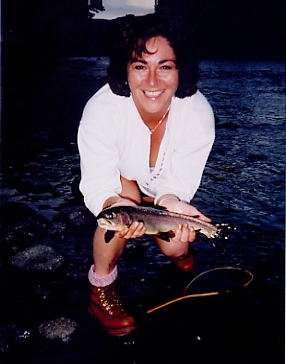
 |
 |
| looking west from Lake Phalarope toward Mt. Washington. photo by Bill Kunz 2002 | me catching a fish. photo by Bill Kunz 2002 |
July 2002: Road Trip!
Days 1 - 3: My son & I drove from Eugene to Lander WY, take-off point for his first NOLS trip (Absaroka Backpacking).
Days 3 - 5: we camped on the Popo Agie at Sinks Canyon State Park, WY. I caught lots of rainbows & a few browns in this lovely pocket water stream just outside of Lander. Most effective flies were the Brown Hackle Bee, Pocket Pal, Elk Hair Caddis, & various soft hackles. Late afternoon of day 5, I dropped Tom at NOLS headquarters & headed for home.
Evening of Day 5: Brooks Lake Creek & Brooks Lake (Togwatee Pass area). Arrived at Pinnacles Camground in time for the evening hatch, & had a good time fishing the creek outlet and wading along the shore of the lake. Caught lots of rainbows in the 6 - 10" class using small dries & emergers (#16-18 comparadun patterns & soft hackles). Out in the lake I caught some slightly larger fish using a #12 Gray Hackle Peacock).
Day 6: Snake River, north
of Jackson WY. Didn't have much time, but found a few fish (12 -
13") hiding behind a gravel bar downstream from Deadman's Bar. Fly was
a #14 Bead Head Prince, always a good one on the Snake.
- Big Wood River at the North
Fork campground above Ketchum, ID (Sun Valley area). Fished at dusk &
caught some healthy rainbows in the 12" class right below my campsite.
The first one took the bead head prince that was already tied on, then
I switched to a cream-colored soft hackle (#16) to imitate the emerging
caddis & that worked very well.
Day 7: Silver Creek ID (S-curves area). The tricos were out but the fish didn't seem to be taking them, at least not at 9:15 or so when I started fishing. I hooked some good fish on mayfly emergers (sparse 'flymph"' type PMD & callibaetis patterns) but they all either shook out the hook or broke me off in the weeds. At approx. 11:30 the adult damselfly action started & they would look at nothing else. Of course I didn't have any adult damsel patterns, so hacked up a big green drake & several other flies with nippers trying to approximate the shape but to no avail. Unless I am mistaken, for a while they were selecting the mating pairs over the spent individuals. What a place! I left about 1:00 pm & arrived at the Ollokot campground in the Hell's Canyon National Recreation Area.
Day 8: back in Oregon
to fish three streams in one day:
- North Pine Creek, Hell's
Canyon area: a steep-gradient pocket water stream holding fish in
every pool & behind every rock. They're small but highly entertaining.
Any dry fly will do the job; this time I stuck mainly with a #16 Elk Hair
Caddis. See below for similar report from summer 2000.
- Powder River below Mason
Dam: first time on this water & it wa a lot of fun -- easy wading
& lots of healthy cooperative fish in the respectable 12-13" bracket.
I started with the Brown Hackle Bee & caught a few; after a while some
PMDs started to hatch, so I put on a #16 yellowish soft hackle & they
loved it.
- Deschutes at Mecca Flats:
set up camp & fished the late evening hatch; hooked a few that got
off. Fished for a while the next morning, but a release from Pelton
Dam was making the water high & off-color, so it was time to head
back to Eugene.
February 17, 2001:
Lower McKenzie below Armitage
Park (also posted to Virtual Flyshop Public Fishing Reports):
It was cold & windy when
I arrived at about 1:00, & several people coming off the river said
fishing was slow. I started prospecting with a #14 March Brown Flymph to
no avail, then saw some rising fish at about 1:30 when a good BWO hatch
got underway near the pipeline. The duns were approx. #18 or maybe #20.
I changed flies & worked it for a while; got some rejections &
then must have put the fish down... first time out in almost two months
& I'm rusty. :-( There were several other anglers at the big riffle,
so I went down to the run above Eugene Sand & Gravel. Three guys were
already out on the spit, so I fished slowly downstream with the Brown
Hackle Bee until they left. One said they had done well both in the
seam & in the slack water of the lagoon. Down on the spit I caught
a very pretty cutt (or maybe cutt-bow) on the Bee. It was a typical Armitage
native; approx. 11" long, very well conditioned, solid silver with light
spotting on the back & faint orange slashes to indicate the cutthroat
heritage. Turned out to be the only fish of the day but very satisying,
esp since I was fishing with a little 6 ft 4 weight "Flylite" :-) On the
way back to the car I nymphed a few runs with a #14 Bead Head Prince; had
one good take & missed the strike. It;s going to take a few more trips
to get the old reaction time back where it belongs... All in all it was
a great afternoon -- no rain to speak of & a river 10 minutes from
town with live insects & native fish. I didn't see any March Browns,
but talked to some other anglers who said they had seen a few. The MBs
should definitely start picking up during the next couple of weeks. One
more thing -- the river is as low as I've ever seen it, maybe even in the
lowest flows of summer. The easy wading is nice, but that's too low for
this time of year; I'm worried about a dry summer.
July 9 - 14, 2000:
Road trip through Central & NE Oregon:
Day One: Camped on the Deschutes
at Trout Creek, & caught a few nice fish (up to 16") during the evening
caddis hatch. Successful patterns were a little black soft-hackle (#18,
crow herl body, starling hackle) & a #18 deer hair caddis with no hackle
& brown dubbed body.
Day Two: Fished around Trout Creek campground again for an hour or so but to no avail. Drove to Troy (north of Enterprise), with a brief time in mid-afternoon spent fishing the Wallowa River E of LaGrande, where I caught a few small ones on dry flies.
Day Three: Hiked up the Wenaha
River from Troy, & had a great time. I saw lots of game, great
wildflowers, & caught many trout, mainly in the 8-10" range but very
good fighters. Probably the biggest was about 11" (not counting a 15" whitefish).
Re patterns, just about anything worked, but of special note were
- Goddard Caddis ( #14)
- Flying Ant (#12 -
14)
- Brown
Hackle Bee (see below)
- a no-name fly, now
termed the "Pocket Pal" because it works so well in pocket water situations
(see pattern below) -- it floats well, is very visible, & the small-stream
fish eat it like crazy, on the Wenaha probably for a stonefly; there were
lots of shucks on the bank.
Day Four: fished the upper Imnaha but didn't do as well as on the Wenaha -- just a couple of fish -- also there were many more mosquitoes at night (Indian Crossing campground).
Day Five: After spending some time gawking at the spectacular wildflowers & landscape at the Hell's Canyon overlook, I spent a couple of hours on North Pine Creek, which runs next to the road below the overlook & the little town of Halfway. Again, the "Pocket Pal" was the ticket -- I quickly lost exact count but caught at least 30 fish (6" - 10") in perhaps 1/4 mile of pocket water. Arrived back on the Deschutes (Mecca Flats this time) for the evening caddis hatch on the Deschutes & caught two good ones (12" - 16").
Day Six: Caught three more Deschutes redsides (12 - 13"), one on an olive emerger fished upstream, & a couple more on the caddis before heading home to Eugene.
Great trip!
March 12, 2000: Fished the lower McKenzie from approximately 1:00 - 3:30 pm. on this sunny & warm spring afternoon. I saw no March Brown hatch activity & caught no fish. There were *lots* of other anglers on the water & everyone I talked with reported little or no action; one guy said he caught a fish on a BWO emerger. Hopefully the March Browns are waiting in the wings, & will make a more spectacular entrance during the next few weeks.
March 5, 2000: Fished the lower McKenzie from approximately 12:30 - 3:00 pm. Saw a few March Brown duns float by at approx. 1:45 - 2:00 but the fish didn't seem to take them. I had good success with a Brown Hackle Bee; landed five nice cutts (or more likely "cuttbows", the local rainbow-cutthroat mutts) all in the 11" - 12" class; LDRd a couple more. I saw some surveyors stakes & flags on the gravel point separating the main stem of the river from the backwater down by Eugene Sand & Gravel. Hope they aren't going to dredge out that section, which is one of my favorites!
February 18, 2000: My wife had a business meeting in Medford, so I drove her down Thursday night after work & went up to the Holy Water (the section of the Rogue River below Lost Creek Dam) on Friday. I was there from approx. noon to 2:30 p.m. What a beautiful day -- perfectly clear & at least 55-60F in the sun. No fish, though, & I didn't see any others caught or even hooked, & not one rise. One guy drifting by said it was very unusual to see *no* rising fish; he thought it was too bright. Tried a wide variety of dries, wets, emergers, weighted nymphs, & wooly buggers, all to no avail. Great water, so maybe it was simply the wrong time of day. FWIW there were a few bugs -- some little dark stones, & starting about 1:00, a consistent (though not heavy) hatch of a dun-colored mayfly approx. #18; probably some kind of Baetis. Fish or not, it was great to be out of the office & this is a gorgeous piece of water.... I hope to go back soon.
December 6, 1999: Holidays & some vacation time are approaching -- please, let the rivers drop & clear! If I ever go fishing, I will post some reports!
Summer, 1999: Didn't fish very often this season, or get anything posted in a timely way. My best outings were late summer-early fall on the Middle Fork of the Willamette, above Oakridge. My partner & I caught mainly hatchery fish, but they were good ones -- big, healthy, & well-colored.
August 1998: Road Trip! The family needed to be in Denver during the weekend of August 15-16, so I volunteered to leave five days early & drive the van across country. This saved airfare and car rental costs & provided some great fishing opportunities:
February 27, 1998 -- Fished the March Brown hatch below Armitage Park with Scott Wilkinson from Bethesda, Maryland. A good hatch materialized at 1:00 pm & lasted for about 45 minutes. Scott picked up this beautiful McKenzie redside on a #14 March Brown Comparadun:
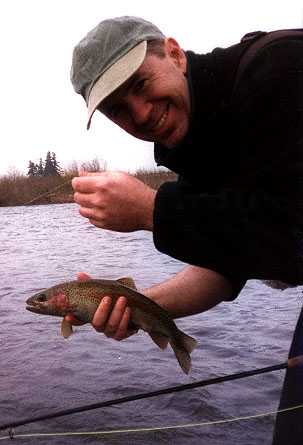
I caught a couple typical (10-11")
McKenzie cutthroat, one on March Brown comparadun, the other post-hatch
on the Brown Hackle Bee. After our fishing,
we had a tour of Greg Tatman Wooden
Boats.

This is a simplified (i.e. wingless) cousin of the McGinty, Western Bee, or Hari Kari Bucktail, developed a few years ago during a bad yellowjacket season. The fly works well wet or dry, in rivers or in lakes. The fish seem to take it for a yellowjacket, stonefly nymph, or dragonfly nymph, depending on where & how it is fished. This pattern was featured in Gene Trump's "Fly Wrap-Up" column in Flyfishing, November/December, 1997 (Portland, OR: Frank Amato).
hook: #10-14 TMC 3761
or equivalent wet fly hook
thread: black or dark
brown
tail: claret hackle
fibers; substitute red-colored Golden Pheasant fibers (from body feathers)
body: black angora
or similar dubbing, ribbed with dark gold floss (Pearsall's #156 Stout)
hackle: brown hen or
soft rooster, palmered through front 1/3 of body. Counterwind a lightly
dubbed thread through the hackle before finishing the head; this improves
durability & provides a full, buggy silhouette.
|
From: "Werner J. Rothbacher" <wrothbac@bowdoin.edu> Subject: Re: oregon flies (was:Fishing guy's address) To: "Andrew R. Bonamici" <bonamici@OREGON.UOREGON.EDU> Organization: Bowdoin College Hi,
|
|
A BHB Testimonial
From Eastern Oregon [Blitzen River]
August 11, 2003 Andrew -- Thanks again for the flies.... I used your bee imitation with great success. I caught at least two dozen fish on them before breaking them off (poor tippet). They held up beautifully.... Best regards, John |
A few notes
on tying durable flies:
Since I'm tying non-commercially, I don't mind taking some extra steps to be
sure that the fly holds up for more than one or two fish.
Securing body materials & hackles: A light coat of head cement (I like Dave's
Flexament) over the shank helps secure body materials. Some kind of cement is
especially important under a tag of flat tinsel, but I like a dab under oval
tinsel as well. A body of flat tinsel always get counterwound with oval tinsel,
& palmered hackles counterwound with wire &/or oval tinsel. I often
run a few turns of thread back through a regular hackle, then forward to the
head before tying off. In the Brown Hackle Bee pattern above, the thread is
lightly dubbed before this step.
Depending on the size of the fly, I always use at least two and usually three
whip finishes of five turns. On trout flies, I usually don't worry about an
overcoat, but wax the thread really well before whip finishing, or put the whips
over a little dab of head cement. Steelhead flies get a final coat of 30-minute
clear epoxy.
Andrew's Blueblack Stone: A
good generic weighted nymph.
hook: #12 TMC 3761, weighted
thread: black or dark brown
tail: black biots
body: abdomen: dark blue floss
overwrapped with closely spaced segments of flattened out 15# brown monofilament
(or dark brown swannundaze)
thorax: black angora mixed with
some brown, palmered with dark brown hen hackle
wingcase: black quill section
with plenty of lacquer for durability
Goddard Caddis:
Another
simplified pattern (antennae are omitted). This floats for a long time
& provides a great silhouette. The flotation comes from the caribou,
so hackle quality isn't critical. This fly has fooled some large trout
in the Deschutes & Snake Rivers. I am currently experimenting with
an all-black version; haven't had time to fish it but will post reports
if it proves successful.
hook: #12-16 standard
dry fly
thread: tan or brown
body: natural caribou
hair spun & clipped into tent-like adult caddis shape
hackle: a few turns
of brown hackle
Irresisticaddis
A downwing version of the
Irresistable. Like the Goddard Caddis above, this is a great combination
of flotation & silhouette.
hook: #12-16 standard
dry fly
thread: tan or brown
tail: moose hair
(optional)
body:caribou or deer
hair spun & clipped. Try tan with a black stripe in the middle.
hackle: For best silhouette,
none. For *huge* flotation & skateability, palmer a stiff hackle through
the spun hair.
wing: Deer or elk hair,
downwing with butts uncovered to form head (a la Elk Hair Caddis).
Pocket Pal
hook: dry fly hook
#12 - 16
tail: brown or cree
hackle fibers
body: black dubbing
ribbed with silver oval tinsel (rib is probably optional)
wing: white calftail
or pref. calf body hair, downwing (caddis/stonefly) style
hackle: brown or cree
dry fly hackle in front of the wing
STEELHEAD
PATTERNS for a box of winter, summer, & greased-line
(low water) flies I tied for a recent benefit auction. Sorry, no pictures
yet.
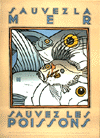
"Save The Sea, Save The Fish"
Poster from Chez Panisse. Sales benefit
the Chez Panisse Foundation.
